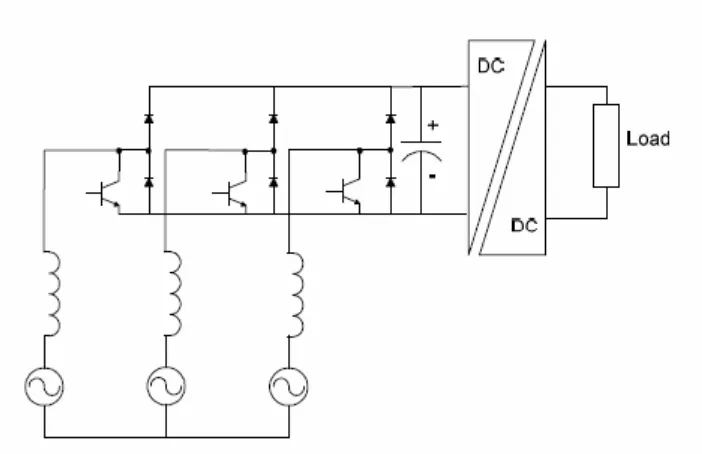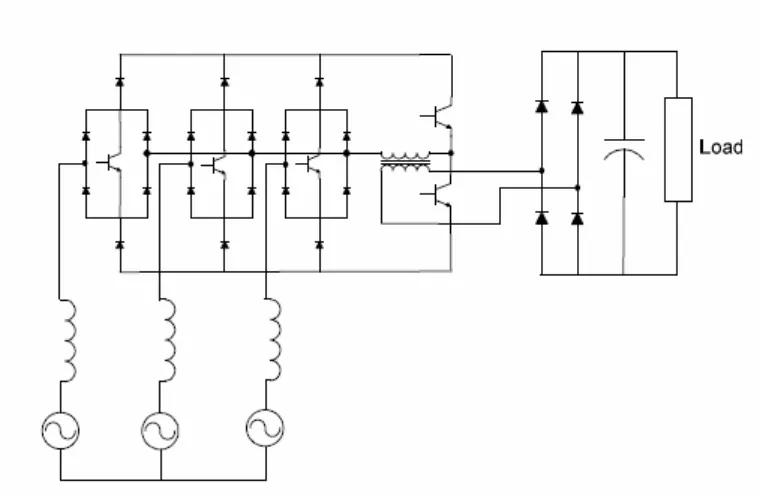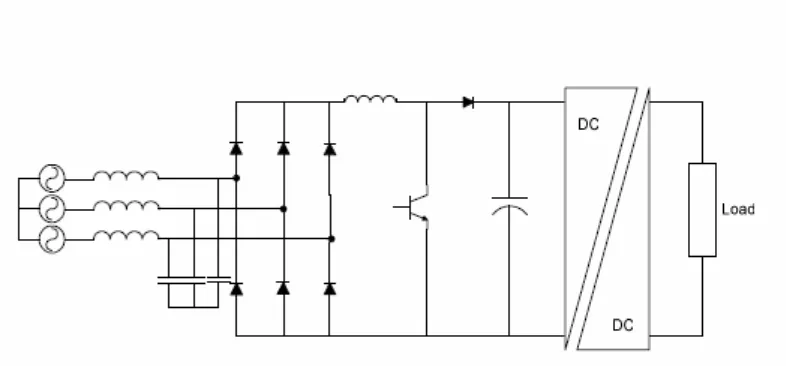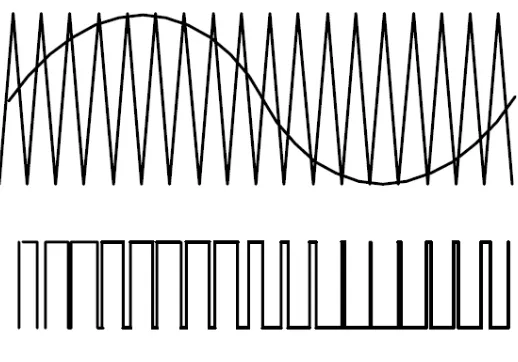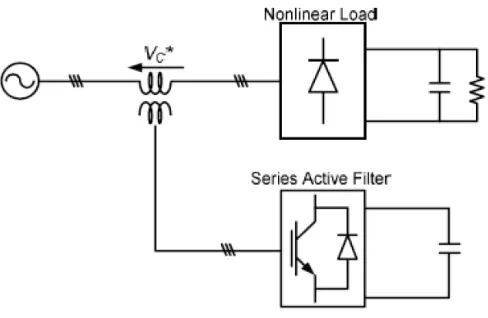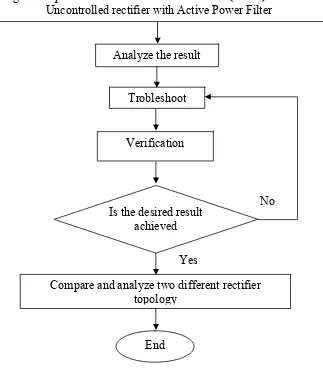THREE PHASE BOOST RECTIFIER DESIGN
ROHAIZAN BIN SAHER
A thesis submitted in partial
Fulfillment of the requirement for the award of the Degree of Master of Electrical Power Engineering
Faculty of Electrical and Electronic Engineering Universiti Tun Hussein Onn Malaysia
ABSTRACT
An electric power can be converted from one form to another form by using power electronics devices. The function of power electronics circuits by using semiconductor devices as switch is modifying or controlling a voltage. The goal of power electronics circuits are to convert electrical energy from one form to another, from source to load with highest efficiency, high availability and high reliability with the lowest cost, smallest size and weight. The term rectification refers to the power circuit whose function is to alter the ac characteristic of the line electric power to produce a “rectified”ac power at the load side that contain the dc value In this project, a study has done for the two types of rectifier topology of alternating current to direct current voltage of a phase boost rectifier with pulse width modulation (PWM) and a three-phase boost rectifier with active power filter (APF). Power factor, shape distortion and
ABSTRACT
An electric power can be converted from one form to another form by using power electronics devices. The function of power electronics circuits by using semiconductor devices as switch is modifying or controlling a voltage. The goal of power electronics circuits are to convert electrical energy from one form to another, from source to load with highest efficiency, high availability and high reliability with the lowest cost, smallest size and weight. The term rectification refers to the power circuit whose function is to alter the ac characteristic of the line electric power to produce a “rectified”ac power at the load side that contain the dc value In this project, a study has done for the two types of rectifier topology of alternating current to direct current voltage of a phase boost rectifier with pulse width modulation (PWM) and a
ABSTRAK
Kuasa eletrik boleh diubah daripada satu bentuk ke bentuk yang lain dengan menggunakan litar peranti kuasa elektronik.Fungsi litar elektronik berkuasa dengan menggunakan peranti semiconductor sebagai suis untuk mengawal dan mengubah arus voltan.Matlamat litar elektronik berkuasa adalah untuk mengubah kuasa elektrik kepada bentuk yang lain, daripada sumber kuasa kepada beban dengan tahap kecekapan yang tertinggi, perihal boleh didapati yang tertinggi ,perihal yang dapat dipercayai tertinggi dengan kos yang paling murah ,saiz dan berat yang paling kecil.Istilah rektifikasi merujuk kepada litar kuasa yang berfungsi untuk mengubah ciri arus ulang alik dalam talian kuasa elektrik untuk menghasilkan arus ulang alik pada beban yang mengandungi
CONTENTS
TITLE i
DECLARATION ii
DEDICATION iii
ACKNOWLEDGEMENT iv
ABSTRACT v
ABSTRAK vi
CONTENTS vii
LIST OF TABLE ix
LIST OF FIGURE x
LIST OF SYMBOLS xii
LIST OF APPENDICS xiii
CHAPTER 1 INTRODUCTION 1
1.1 Introduction 1
1.2 Problem of Statement 2
1.3 Objective of Project 3
1.4 Scope of Study 3
1.5 Thesis Outline 4
CHAPTER 2 LITERATURE REVIEW 5
2.1 Introduction 5
2.2 Boost Derived Rectifier Topologies 5 2.2.1 Three-Phase Six Switch Boost Rectifier 5 2.2.2 Three-Phase Four Switch Boost Rectifier 6 2.2.3 Three Switch Boost Power Converter 7
2.2.5 Single Switch Boost Power Converter 9 2.3 Boost Rectifier with Harmonic Circuit 10
2.3.1 Three-Phase, Single Switch Boost Rectifier 10
2.4 Modulation Techniques 11
2.4.1 Sinusoidal PWM 11
2.4.2 Generalized Discontinuous pulse width 12 modulation (GDPWM).
2.5 Active Power Filter 12
CHAPTER 3 METHODOLOGY 15
3.1 Introduction 15
3.2 Development of Three Phase Boost Rectifier Design 16 3.3 Operation of Three Phase Boost Rectifier 17
3.4 Model of Three Boost Rectifier 20
3.5 Active Power Filter using closed loop concept 23
3.5.1 Hyteresis Current Control 24
CHAPTER 4 SEMULATION RESULT AND ANALYSIS 26
4.1 Introduction 26
4.2 Simulation system via MATLAB/Simulink 26
4.2.1 Nonlinear Load 28
4.2.1.1 Uncontrolled Rectifier Load (Resistor) 28 4.2.1.2 Uncontrolled Rectifier Load 34
(Resistor and Inductance)
CHAPTER 5CONCLUSIONS AND RECOMENDATIONS 39
FOR THE FUTURE WORKS
5.1 Conclusion 39
5.2 Recommendations for Future Work 40
REFERENCES 42
LIST OF TABLE
3.1 Variable used for three-phase boost rectifier model 17
3.2 Switching mode for boost rectifier 19
LIST OF FIGURE
2.1 Three-Phase Six Switch Boost Rectifier 6
2.2 Four Switch Boost Power Converter System 7
2.3 Three Switch Boost Power Converter System 8
2.4 Vienna Rectifier 9
2.5 Single Switch Boost Power Converter 10
2.6 Single-switch three-phase DCM boost rectifier 11 with 5th-harmonic trap.
2.7 Sine-triangle PWM 12
2.8 Shunt active power filter 13
2.9 Serie active power filter 13
3.1 Flow chart of Three-Phase Boost Rectifier Design 16
3.2 Topology of Three Phase Boost Rectifier 17
3.3 Block diagram of three phase active power filter 24 with Hyteresis current control
3.4 Block diagram of hysteresis control technique 25 4.1 Three Phase Boost Rectifier with Pulsewidth Modulatian (PWM) 27
4.2 Three Phase Boost Rectifier with APF 27
4.3 Nonlinear Block (Resistor) 29
4.4 Simulation result : Uncontrolled Rectifier 30
4.5 Simulation result :PWM rectifier 30
4.6 Simulation Result : Active Power Filter (APF) 31
4.7 FFT diagram for uncontrolled rectifier 31
4.8 FFT diagram for PWM rectifier 32
4.9 FFT diagram for uncontrolled rectifier with APF 32
4.10 Uncontrolled Rectifier output 33
4.11 PWM rectifier output 33
4.12 Uncontrolled rectifier with APF 34
4.14 Simulation result :Uncontrolled rectifier (R-L Load) 35 4.15 Simulation result : PWM rectifier (R-L Load) 36 4 16 Simulation result: Active Power Filter (R-L Load) 36 4.17 FFT diagram for uncontrolled rectifier (R-L Load) 37
4.18 FFT diagram for PWM rectifier (R-L Load) 37
LIST OF SYMBOLS
AC - Alternate Current
DC - Direct Current
KVL - Kirchhoff Voltage Law
KCL - Kirchhoff Current Law
APF - Active Power Filter
THD - Total Harmonic Distortion
PWM - Pulse Width Modulation
GPWM - Generalized Discontinuous Pulse Width Modulation
icompA, B C - Reference currents
PI - Proportional Integral
PLL - Phase Locked Loop
HBCC - Hysteresis Band Current control
α - Alpha
β - Beta
PFC - Power Factor Correction
PF - Power Factor
Vas,Vbs, Vcs - Input AC side voltage
Ia,Ib,Ic - Phase current
ra,rb,rc - Per phase resistance
IL - Load Current
S11, S21,S31 - Switching function on top devices S12, S22 .S32 - Switching function on bottom devices
LIST OF APPENDICES
APPENDIX TITLE PAGE
A Parameter for three phase boost rectifier 47
with pulsewidth modulation (PWM)
B Output Voltage (Vdc) and Power Factor 49 Calculation
C Circuit Diagram 52
D Result and Simulation 56
E Table for effects of harmonic on equipment 69
CHAPTER 1
INTRODUCTION
1.1 Introduction
A switching power rectifier in the power system is convert one level of electrical energy into another level of electrical energy. Converters in the AC to DC conversion field are the most widespread [G. Chesi ,2009] and the operation of a converter can be explained in terms of the input quantities, output quantities, and the switching pattern used to obtain the preferred output. In industrial applications where
three-phase ac voltages are available, it is preferable to use three-phase rectifier circuits, compared to single-phase rectifiers. Three-phase rectifiers have the following advantages compared with single-phase rectifiers [Mohan, N., Undeland, T., and Robbins ,1995]
a. higher output voltage for a given input voltage
b. lower amplitude ripples, i.e. output voltage is smoother
c. higher frequency ripples, simplifying filtering
d. higher power-handling capability
e. higher overall efficiency
Type of semiconductor device used in the rectifier are different following application as [Enrique Acha ,1997]:
a. Uncontrolled rectifiers - Diodes as the switches
b. Phase-controlled rectifiers - SCR (silicon controlled rectifiers)
Among three-phase AC to DC rectifiers, boost-type topologies are frequently used because of continuous input currents and high output voltages. The ability to control the system to obtain unity power factor operation of a boost rectifier is important feature of the rectifier topology. The power factor (PF) is defined as the ratio of working power to apparent power. The power quality problems, such as large values of harmonics, poor power factor and high total harmonic distortion, are usually associated with operation of three phase AC to DC converters. An increase in the current harmonics and a decrease in the displacement power factor in AC power lines produced by diode and thyristors are a serious problem, thereby highlighting the importance of the boost rectifier in minimizing these problems.
Active power filter (APF) or pulsewidth-modulation (PWM) rectifiers in distribution systems represents the best solution, in terms of performance and effectiveness, for elimination of harmonic distortion as well as power factor correction, balancing of loads, voltage regulation and flicker compensation. Sinusoidal PWM [P. Wood , 1981] is technique employed where the sinusoidal waveform or modulation signal is compared with a very high frequency triangle or carrier signal to obtain the switching pulses for the device.
The shunt APF, connected in parallel with the non-linear load, is commonly
utilized to compensate for current disturbances while the series APF is utilized to compensate for voltage disturbances.
The aim of the project is to study an existing three-phase boost rectifier and design a new three-phase boost rectifier topology with minimum value of current harmonics. In this project, trends and future prospects in new three-phase boost rectifier topology with pulsewidth modulation (PWM) and active power filter (APF) are presented and the simulation result will be shown. A method of identification of supply current will be developed by using MATLAB/Simulink for elimination of the harmonics of current and to obtain a sinusoidal current of line.
1.2 Problem of Statement
problems, such as large values of harmonics, poor power factor and high total harmonic distortion, are usually associated with operation of three phase AC/DC converters especially nonlinear load. There have been many approaches to mitigate the harmonics in the rectifier system. They include the following:
a. active power filters;
b. six-switch pulsewidth-modulation (PWM) rectifiers; c. power-factor correction (PFC) by boost converters; d. multipulse rectifiers;
e. harmonic current injection method.
1.3 Objective of Project
The objective in this project is to develop and compare in term of method or topology of three phase boost rectifier which more efficient and able to solve the nonlinear problem with optimum way. Six-switch pulsewidth-modulation (PWM) rectifiers and active power filter (APF) will be used in this project. The APC topology is unique
because the configuration is more reliable. A failed shunt filter does not immediately affect the loads side.
1.4 Scope of Study
1.5 Thesis Outline
The thesis is organized into 5 chapters namely the introduction, literature reviews, methodology, simulations and results analysis, conclusion and recommendation.
Chapter I discuss the background and general idea of the proposed project. The objective and scope of this project are state in this chapter.
Chapter II conducts a detailed literature survey on the previous work done in three phase boost The chapter also includes sections on the past work done in Pulsewidth Modulation (PWM) boost rectifier and boost rectifier with active power filter (APF)
Chapter III details on research methodology of each design state. Two topologies for the connection of boost rectifier; pulsewidth modulation and active power filter are discussed in this chapter with operation of the system.
Chapter IV displays the simulation result and analyze the compensation two different three phase boost rectifier topologies;pulsewidth modulation and active power filter subject to a typical nonlinear load. The simulation design and the result of each stage will be observed.
CHAPTER 2
LITERATURE REVIEW
2.1 Introduction
This chapter presents a review on the various works previously done on three phase boost rectifier. A three-phase system has certain inherent advantages over a single-phase system. In this chapter discusses the nature of three-phase rectifier and reports the different types of three phase topologies. The topologies are discussed and various strengths and weakness highlighted.
2.2 Boost Derived Rectifier Topologies
Three-phase boost PFC power rectifier have traditionally been the preferred topology for high power applications due to their symmetric current drawing characteristics. A disadvantage to any boost derived topology is the inability to control startup inrush currents and output short circuit conditions, unless bi-directional power flow is possible. The following subsections describe various boost derived topologies.
2.2.1 Three-Phase Six Switch Boost Rectifier
(Figure 2.1). It also has good current quality and low EMI emissions [V. Blasko, V. Vaura and W. Niewiadomski ,1998]. The use of bidirectional switches also results in the ability to control the output voltage down to zero, thus, eliminating the problem that boost topologies have with regard to startup inrush currents and output short circuit protection. Unidirectional switches can be used for simplicity at the expense of current control capabilities. The converter is controlled by an output voltage loop for output regulation, and inner current loops which shape the input currents according to their sinusoidal references. The input inductors form part of the boost topology and, as such, work at the switching frequency. As a result, input inductors operating at switching frequencies are smaller in size compared with line frequency input inductors.
Figure 2.1 : Three-Phase Six Switch Boost Rectifier
2.2.2 Three-Phase Four Switch Boost Rectifier
removes the need for a third converter leg. A disadvantage is that even with a slight imbalance in the supply system, the converter performance may deteriorate considerably. DC-DC converter stage is still needed to provide isolation, voltage transformation and ripple reduction.
Figure 2.2: Four Switch Boost Power Converter System
2.2.3 Three Switch Boost Power Converter
The three switch boost derived converter proposed in [S. Zheng and D. Czarkowski,2007] works on the principle of current control. When two switches are conducting, the phase with the larger supply voltage is connected to the positive rail,
while the phase with the smaller supply voltage is connected to the negative rail (Figure 2.3). As a result, the phase shift angle between the modulation references and supply
Figure 2.3 : Three Switch Boost Power Converter System
2.2.4 Vienna Rectifier
Another three-switch boost derived converter, also called the Vienna rectifier, is a unidirectional three-level PWM converter (Figure 2.4) and, as a result, suffers from startup inrush currents. The input stage creates a DC voltage across the two switches connected to the transformer primary. These two switches, in turn, regulate the voltage being applied to the primary of the transformer. Accordingly, they are able to control
Figure 2.4: Vienna Rectifier
2.2.5 Single Switch Boost Power Converter
Figure 2.5 : Single Switch Boost Power Converter
2.3 Boost Rectifier with Harmonic Circuit
The quantity of input current harmonics is an important parameter to unsure the performance of a switching mode.
2.3.1 Three-Phase, Single Switch Boost Rectifier
Figure 2.6: Single-switch three-phase DCM boost rectifier with 5th-harmonic trap.
The harmonic-injection method does not increase the voltage stress of the boost switch. In the technique presented in [Y. Jang and M. M. Jovanovic,1997], a voltage signal which is proportional to the inverted ac component of the rectified three-phase line-to-line input voltage is injected into the output-voltage feedback loop to vary the duty cycle of the rectifier within a line cycle in order to reduce the fifth-order harmonic and improve the THD of the rectifier input currents.
2.4 Modulation Techniques
There are two different types of modulation techniques applied for pulse width modulation (PWM)[ P. Wood,1981]
2.4.1 Sinusoidal PWM
wave is higher in magnitude the corresponding value of the switching pulse is high (has a value = 1) and when the sine wave is lower than the carrier, the pulse is low (has a value = 0). This is shown graphically in figure 2.7.
Figure 2.7 : Sine-triangle PWM
2.4.2 Generalized Discontinuous pulse width modulation (GDPWM).
Technique is represents the ac side voltages of the converter as a space vector. Each active state is represented as a vertex of a hexagon, while the null vectors are represented at the centre of the hexagon. Depending on the sector in which the reference vector lies, the switching times are calculated to generate the desired reference vector.
2.5 Active Power Filter
shown in figure 2.8. is the most fundamental system configurations where the shunt active power filter is controlled to draw and inject compensating current, Ic * to the power system and cancel the harmonic currents on the AC side of a general purpose rectifier. Thyristor or diode rectifier normally used in shunt active power filter.
Figure 2.8. Shunt active power filter
The series active power filter show as figure 2.9 is connected in series with the utility by a matching transformer. The compensation voltage VC* is used to cancel the voltage harmonics of the load with high capacitance in the DC side.
Figure 2.9 . Serie active power filter
[image:25.595.193.437.523.682.2]for power conditioning; it provides functions such as reactive power compensations, harmonic compensations, harmonic isolation, harmonic damping, harmonic termination, negative-sequence current or voltage compensation and voltage regulation. Active power filter consists of an inverter with switching control circuit. The inverter of the active power filter will generate the desired compensating harmonics based on the switching gates provided by the controller. The total harmonic distortion (THD) of a current or voltage is equal to the effective value of all the harmonics divided by the effective value of fundamental.
The equation of a distorted current is:
Total Harmonic Distortion (THD) = (2.1)
The equation of a distorted voltage is:
Total Harmonic Distortion (THD) = (2.2) The IEEE Standard 519-1992 specifies the maximum percentage THD permitted for both current distortion and voltage distortion. [Theodore R.Bosela] . The THD in voltage and current are defined as:
(2.3)
(2.4)
CHAPTER 3
METHODOLOGY
3.1 Introduction
3.2 Development of Three Phase Boost Rectifier Design
Is the desired result achieved
Compare and analyze two different rectifier topology
End
Analyze the result
Trobleshoot
Verification Start
Study the topology of rectifier
Literature review
Simulate the nonlinear load and analyze the generated harmonis
Design three phase boost Pulsewidth Modulation (PWM) rectifier and Uncontrolled rectifier with Active Power Filter
No
[image:28.595.159.482.354.724.2]Yes
3.3 Operation of Three Boost Rectifier
[image:29.595.129.495.279.462.2]The application areas of the boost rectifier are varied and exhaustive due to the efficient utilization of power in the rectification process, and the boosting of the output voltage. The topology of the three-phase boost rectifier is shown in figure 3.2. The parameters of the rectifier are as defined in table 1
Figure 3.2: Topology of Three Phase Boost Rectifier
Table 3.1.: Variable used for three-phase boost rectifier model
Vas,Vbs, Vcs Input AC side voltage Ia,Ib,Ic Phase current ra,rb,rc Per phase resistance
IL Load Current
S11, S21,S31 Switching function on top devices
S12, S22 .S32 Switching function on bottom devices
RL Load resistance
[image:29.595.163.462.569.796.2]The three-phase boost rectifier comprises of six switches that are switched using sinusoidal pulse width modulation technique. In general, the operation of a converter can be explained in terms of the input quantities, output quantities, and the switching pattern used to obtain the desired output. The switching pattern of the switches in the converter is obtained in accordance with Kirchhoffs voltage law (KVL) and Kirchhoffs current law (KCL). The ON and .OFF. states of a single switch are assumed to have values 0 and 1.
In a three-phase rectifier, the input ac voltages are defined and the output dc voltage is dependent on the input quantities as well as the switching pattern of the rectifier. The switching pattern for any converter can be expressed as a function, which is a mathematical representation of the switching pattern, called an existence function. [P. Wood,1981]
Table 3.2: Switching mode for boost rectifier
S.No S11 S21 S31
1 0 0 0 2 0 0 1 3 0 1 0 4 0 1 1 5 1 0 0 6 1 0 1 7 1 1 0 8 1 1 1
From the above eight possible switching modes, only six modes can be used in synthesizing a dc voltage, and are called active states. The two states (1 and 8) are called null states as these states do not result in an output dc voltage and are thereby inactive.
Equations (3.1) to (3.3) show that at no instant of time can the top and bottom devices of the same leg be ON simultaneously
(3.1)
(3.2)
3.4 Model of Three Boost Rectifier
The model of the three-phase rectifier is shown in figure 3.2. The switching modes and the different types of modulation schemes have been discussed in chapter II The next step in the analysis is the derivation of the model equations of the boost rectifier. In this section, the model equations of the boost rectifier are derived in the abc reference frame and then transformed to the qd reference frame
The voltage equations for the boost rectifier in the abc reference frame are:
(3.4)
(3.5)
(3.6)
The phase resistances and inductances are assumed to be balanced i.e. ra = rb = rc and La = Lb = Lc,where the phase impedance is
(3.7)
The phase voltages are assumed to be balanced and have a peak value of Vm. Hence the phase voltages can be defined as
(3.8)
(3.9)
φv is the voltage phase angle and ω is the frequency of the voltage in rad/sec. Vno is the neutral voltage
Substituting Equations (3.1) - (3.3) in (3.4) - (3.5), the voltage equations for the boost rectifier can be expressed in terms of the switching functions of the top devices as:
(3.11)
(3.12)
(3.13)
The phase impedance Z can be substituted for in Equations (3.11) to (3.13) by substituting equation (3.7).
(3.14)
(3.15)
(3.16)
The final state equation that completes the system model for the boost rectifier is the capacitor voltage equation. The capacitor voltage equation for the boost rectifier is expressed in terms of the load current IL and the dc current at the output of the rectifier
(3.17)
Where Ip the output is current defined in terms of the switching functions of the top
(3.18)
Substituting equation (3.16) in (3.15)
(3.19)
The next step in the analysis is the elimination of the neutral voltage in equations 3.14 to 3.16. The neutral voltage is eliminated by adding equations (3.14) to (3.16). As the system voltages Vas, Vbs and Vcs are balanced
Hence the neutral voltage can be expressed in terms of the switching functions as
(3.20)
Using equation (3.20), the neutral voltage can be eliminated in the voltage equations 3.14 to 3.16 resulting in
(3.21)
(3.22)
(3.23)
The simulation of the three-phase boost rectifier is using the following equations:
(3.25)
(3.26)
(3.27)
The switching functions for the rectifier are obtained by sine-triangle PWM. The modulation signals are chosen to have a magnitude of 0.8 and the frequency of the modulation signals (which is equal to the frequency of the supply voltages) is taken as 50Hz. The load resistance is assumed to be 50Ω
3.5 Active Power Filter using closed loop concept
Block diagram of three phase active power filter with Hysteresis current controller show as figure 3.3 in the system configuration and design that was based on pulse-width modulated (PWM) voltage source inverter. The filter was shunt-connected with the load that being compensated. The basic concept is for the harmonic current cancellation so that the current being supplied from the source was sinusoidal.
The desired compensated harmonics icompA*,icompB*and icompC *of each phase are used as the reference currents in the system. This allows the proposed active power filter to produce the output current, icompA, icompB and icompC according to the reference current icompA*,icompB *and icompC *from the instantaneous active and reactive power calculation.
from the difference between the referencecurrent, icomp *and the feedback or actual current, icomp . This current error signal is then fed into hysteresis controller to generate the switching pattern of the VSI. Hysteresis control schemes are based on a nonlinear feedback loop with two-level hysteresis comparators. Six sets of appropriate gate switching signals are generated and are sent to the voltage source inverter. The desired compensated current of each phase is generated by the three phase inverter and is injected back into each power line to compensate the distorted lines current. This inverter uses dc capacitors as the supply and can switch at a high frequency to generate a signal which will cancel the harmonic from the nonlinear load.
Figure 3.3: Block diagram of three phase active power filter with Hyteresis current control
REFERENCES
G. Chesi. Estimating the domain of attraction for non-polynomial systems via LMI optimizations. Automatica, 45(6):1536–1541, 2009.
Mohan, N., Undeland, T., and Robbins, W.: ‘Power electronics converters, applications and design’, (John Wiley & Sons Inc, 1995)
Enrique Acha. Switching Power Supply Design. McGraw-Hill, 1997
P. Wood, Switching Power Converters, Van Nostrand Reinhold Company, 1981
V. Blasko, V. Vaura and W. Niewiadomski, “Sampling of Discontinuous Voltage and CurrentSignals in Electrical Drives: A System Approach”, IEEE Transactions on Industrial Applications,Vol. 34, No. 5, pp. 1123-1130, Sept. 1998.
Abraham Pressman, “Switching Power Supply Design”, McGraw-Hill Inc., 1991
S. Zheng and D. Czarkowski, “Modelling and Digital Control of a Phase-Controlled
Series-Parallel Resonant Converter”, IEEE Transactions on Industrial
Electronics, Vol. 54, No. 2, pp.707-715, April 2007.
D.M. Mitchell, “Pulsewidth Modulator Phase Shift”, IEEE Transactions on Aerospace Electronics, Vol. AES-16, No. 3, pp. 272-278 May 1980.
T. Nussbaumer, M.L. Heldwein, G. Gong, S. Round, and J. Kolar, “Comparison of PredictionTechniques to Compensate Time Delays Caused by Digital Control of
a Three-Phase Buck-Type PWM Rectifier System”, IEEE Transactions on
Q. Huang and F. C. Lee, “Harmonic reduction in a single-switch, three phase boost
rectifier with high order harmonic injected PWM,” in Conf. Rec. IEEE
PESC’96, 1996, pp. 1266–1271.
Y. Jang and M. M. Jovanovic, “A novel, robust, harmonic injection method for single- switch, three-phase, discontinuous-conduction-mode boost rectifiers,” in Conf. Rec. IEEE PESC’97, 1997, pp. 469–475
B. K. Bose, Power Electronics and Variable Frequency Drives, IEEE Press, Piscataway, NJ, 1996
Chua, Leon. O, Linear and Nonlinear Circuits, McGraw-Hill, New York, 1987
S.Fukuda and K. Koizumi, . Optimal Control of a Three Phase Boost Rectifier for Unity Power Factor and Reduced Harmonics,. Proc International Conference Power Electronics and Drive Systems, vol. 1, pp. 34-39, February 1995.
Olorunfemi Ojo, Olufemi Osaloni, Parag Kshirsagar, . The Generalized Discontinuous PWM Modulation Scheme for Theree-Phase Voltage Source Inverters,. Proc
IEEE IECON 2003 Annual Conference, Vol 2. pp.1629-1636, 2005.
Q. Huang, F.C. Lee, Harmonic reduction in a single-switch, three-phase boost rectifier with high order harmonic injected PWM, in: Proceedings of the IEEE, PESC Conference, Baveno, Italy, 1996, pp. 1266–1271.
J.W. Kolar, H. Ertl, F. Zach, Space vector-based analytical analysis of the input current distortion of a three-phase discontinuous-mode boost rectifier system, in: Conference on Record IEEE PESC, 1993, pp. 696– 703.
T.S. Key, J.-S. Lai, IEEE and International Harmonic Standards Impact on Power Electronic Equipment Design, IEEE, IECON, New Orleans, USA, 1998, pp.430-436.
P. Barbosa, F. Canales, J.-C. Crebier, F.C. Lee, Interleaved three-phase boost rectifiers operated in the discontinuous conduction mode: analysis, design considerations and experimentation, IEEE Trans. Power Electron. PE-16 (5) (2001) 724–734
SGS-Thomson Microelectronics, "Power Switching Regulators," Designer's Booklet, 1st edition,September 1993
C. Zhou, Design and Analysis of an Active Power Factor Correction Circuit, M. S. Thesis, VirginiaPolytechnic Institute and State University, Sept. 1989
M. J. Kocher, R. L. Steigerwald, "An AC-to-DC Converter with High Quality Input
Waveforms," IEEE Trans. on Industry Applications, Vol. 1A-19, No. 4,
July/August, 1983, pp. 586-599
E Acha,V.G.Agelidis,O.Anaya-Lara,T.J.E. Miller,(2002). ”Power Electronic Control in Electrical Systems”,Planta Tree,Newnes , pp. 27, 72
Emílio F. Couto, Júlio S. Martins, João L. Afonso, Simulation Results of a Shunt Active
Power Filter with Control Based on p-q Theory, Department of Industrial
Electronic University of Minho
H. Doğan, R. Akkaya, (March 18 - 20, 2009).” A Simple Control Scheme for Single- Phase Shunt Active Power Filter with Fuzzy Logic Based DC Bus Voltage
Controller”, Proceedings of the International Multi Conference of Engineers and Computer Scientists 2009 Vol IIIMECS 2009, Hong Kong
Mohan,N,Undeland, T and Robbins, W(1995).Power Electronics-Converters, Application, and Design. 2nd.edition. Canada:John Wiley & Sons, Inc.
M. Rastogi, R. Naik, and N. Mohan, “A comparative evaluation of harmonic reduction techniques in three-phase utility interface of power electronic loads,” in IEEE, /AS Ann. Meet., Con$ Rec., 1993,
N. Mohan, M. Rastogi, and R. Naik, “Analysis of a new power electronics interface with approximately sinusoidal 3-phase utility currents and a regulated dc output,” IEEE Trans. Power Delivery, pp. 540-546, Apr. 1993.
Mohan, N., Undeland, T., and Robbins, W.: ‘Power electronics– converters, applications and design’, (John Wiley & Sons Inc, 1995)
Chung, D.W., and Sul, S.K.: ‘Minimum-loss strategy for three-phase PWM rectifier’, IEEE Trans. Ind. Electron., 1999, 46, (3), pp. 517–526
Alexa, D., and Lazar, A.: ‘Optimisation of PWM Techniques with Partially Constant Modulating Waves’, Electr. Eng., 2000, 82, (5), pp. 263–272
M. P. Kazmierkowski, R. Krishnan, and F. Blaabjerg, Control in Power Electronics. San Diego, CA: Academic, 1999
Y. Sato and T. Kataoka, “A current-type PWM rectifier with active damping function,” IEEE Trans. Ind. Appl., vol. 32, no. 3, pp. 533–541, May/Jun. 1996.
M. H. Bierhoff and F. W. Fuchs, “The generically equal harmonic behavior of three phase PWM voltage and current source converters,” in Proc. Power Electron. Intell. Control Energy Conserv., Warsaw, Poland, 2005
Ashish Tewari,(2002). Modern Control Design with MATLAB and Simulink, British Library Cataloguing in Publication Data.
JOs Arrillaga, Neville R Watson,(2003). ”power system Harmonics”, University of Canterbury, Christchurch, New Zealand, Wiley, second edition, pp. 156-168
H. Fujita and H. Akagi, “A practical approach to harmonic compensation in power systems—Series connection of passive and active filters,” IEEE Trans. Ind. Appl., vol. 27, no. 6, pp. 1020–1025, Nov./Dec. 1991


